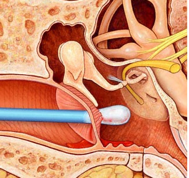A perforated eardrum is a hole or rupture in the eardrum, a thin membrane which separates the ear canal and the middle ear. The medical term for eardrum is the tympanic membrane.
A perforated eardrum is often accompanied by decreased hearing and occasional discharge. Pain is usually not persistent.
Causes of Eardrum Perforation
The causes of a perforated eardrum are usually from trauma or infection. A perforated eardrum can occur:
- If the ear is struck squarely with an open hand.
- With a skull fracture
- After a sudden explosion
- If an object is pushed too far into the ear canal. (such as a cotton bud, bobby pin, or stick)
- As a result of hot slag or acid entering the ear canal. (from welding)

Middle ear infections may cause pain, hearing loss and spontaneous rupture (tear) of the eardrum resulting in a perforation. In this circumstance, there may be infected or bloody drainage from the ear. In medical terms, this is called otitis media with perforation.
On rare occasions, a small hole may remain in the eardrum after a previously placed grommet either falls out or is removed by the doctor.
Most eardrum perforations heal spontaneously within weeks after rupture, although some may take up to several months. During the healing process, the ear must be protected from water and trauma. Those eardrum perforations which do not heal on their own may require surgery.
Effects on Hearing from Perforated Eardrum
Usually, the larger the perforation, the greater the loss of hearing. The location of the hole (perforation) in the eardrum also affects the degree of hearing loss. If severe trauma (e.g. skull fracture) disrupts the bones in the middle ear which transmit sound, the loss of hearing may be quite severe.
If the perforated eardrum is due to a sudden traumatic or explosive event, the loss of hearing can be great and ringing in the ear (tinnitus) may be severe. In this case, the hearing usually returns partially, and the ringing diminishes in a few days. Chronic infection as a result of the perforation can cause major hearing loss.
Treatment of the Perforated Eardrum
Before attempting any repair of the perforation, a hearing test should be performed. The benefits of closing a perforation include prevention of water entering the ear while showering, bathing or swimming (which could cause ear infection), improved hearing, and diminished tinnitus. It also may prevent the development of cholesteatoma (skin cyst in the middle ear), which can cause chronic infection and destruction of ear structures.
If the perforation is very small, Otolaryngologists may choose to observe the perforation over time to see if it will close spontaneously. If the perforation does not heal by itself, surgery is usually advised.
There are a variety of surgical techniques, but all basically place tissue across the perforation allowing healing. The name of this procedure is called tympanoplasty. Surgery is typically quite successful in closing the perforation permanently and improving hearing. It is usually done on an outpatient basis under a general anaesthetic.
Your doctor will advise you regarding the proper management of a perforated eardrum.
